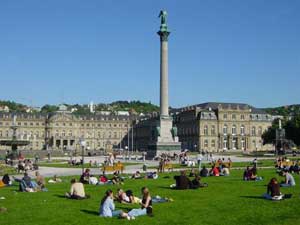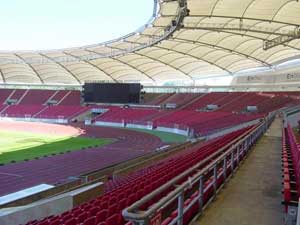
Germany 2006 FIFA World Cup VenuesFIFA World Cup Host Cities - STUTTGARTStuttgart city profile
In the 14th Century Stuttgart is elevated to the seat of power in Wuerttemberg; the industrialisation in the mid-19th Century is the beginning of Stuttgart's rise to one of the largest conurbations in Germany. Today the capital of Baden-Wuerttemberg is one of the largest major industrial cities in Europe housing the headquarters of the global concern DaimlerChrysler at its centre. By hosting the 1986 European Track and Field Championships Stuttgart established its reputation as an international sports city. The excellent organisation, courtesy and enthusiasm of the spectators prompted the International Olympic Committee, IOC, to award the Olympic Cup to the capital of Baden-Wuerttemberg. Further examples of sporting highlights in the Swabian Metropolis are matches of the 1974 FIFA World Cup and of EURO '88, and the 1993 IAAF Track and Field World Championships. The football Bundesliga club VfB Stuttgart is the sporting symbol of Stuttgart, playing home matches at Gottlieb-Daimler-Stadion for many years. Since 1945 19 international matches have been held here. Major Events at the Stuttgart Gottlieb-Daimler-Stadion
Stuttgart stadium profilePopulation: 590,000
The third phase of the 2006 FIFA World Cup modernisation programme began in January 2004 and is scheduled to be completed by the end of 2005. A new seating tier will be created opposite the main stand, electronic access controls installed and two new video screens mounted, at 115 square metres viewable area and 11 tonnes apiece, the biggest of their kind in Europe. The original Neckar-Stadion was built in 1933 to a design by architect Paul Bonatz. From 1949-51, a new open stand was built opposite the main stand and between 1955-56, the Cannstatter and Untertürkheimer ends were extended. Further extensions followed in 1971-73 and 1974 (main stand), and the pitch was modernised in 1990. The Gottlieb-Daimler-Stadion was improved to FIFA World Cup standard as early as 1999-2001, with an investment of around DM 107m on the main stand. The focal point was the new Business Centre with 44 executive boxes, 1,500 business seats, a multi-storey car park with direct access, and facilities for visitors, athletes and the media. The stadium is home to renowned Bundesliga outfit VfB Stuttgart. A highlight of the new ground is the textile roof covering, with a supporting structure following the principle of a horizontal hub and spoke system, its fine and intricate lattice somehow reminiscent of the nearby acres of vines. The roof is created from PVC coated polyester fibre and covers the stands with some 34,000 square metres of material at heights varying between 18 and 35 metres. Financing: (*) "Total Seating Capacity" means the Gross Capacity less the seats unavailable for use due to restricted views and security/contingency reserves for the 2006 FIFA World Cup. This capacity is estimated and may change once these deductions are finally determined.
|
|||||||||||||||||||||||
Recommended Sportsbook
Bookmaker Sportsbook is a recognized sports betting leader since 1985. BookMaker provides safe, legal, and secure betting on major sporting events, as well as horse racing, casino, and poker entertainment, from any location in the world, 24 hours a day 7 days a week. Bookmaker is the number one legal online sports betting and entertainment center of America. Bonded and fully licensed by the Government of Costa Rica. With a reputation like this everyone should have an account.
Bookmaker covers all needs for any real gambler. If you do not have an account with Bookmaker you are making a very big mistake. Signing up now is better than ever as gives you the best bonuses available. With an array of bonuses and the best reputation, Bookmaker is a must have for A list sportsbook betting fans. Sign up today!
 The Romans appreciated the idyllic and central location of the valley basin of the settlement Cannstatt, when they built a citadel there around 85/90 AD. By founding the stud farm "Stuotgarten" in 950 AD, Duke Luidolf of Swabia laid the foundation stone for the city to be created 33 years later and gave it today's name, Stuttgart. After that continuous progress is made.
The Romans appreciated the idyllic and central location of the valley basin of the settlement Cannstatt, when they built a citadel there around 85/90 AD. By founding the stud farm "Stuotgarten" in 950 AD, Duke Luidolf of Swabia laid the foundation stone for the city to be created 33 years later and gave it today's name, Stuttgart. After that continuous progress is made.  The citizens of Stuttgart have been treated to sporting, cultural and even historic scenes aplenty at their Gottlieb-Daimler-Stadion. Germany met Switzerland here in 1950 in the first international on German soil following the end of the Second World War. Forty years later, on 19 December 1990, the stadium hosted the first international since reunification, another match-up between the Germans and the Swiss. The ground has been the venue for the European Champions Cup Final, a concert by the Rolling Stones, FIFA World Cup and European championship matches, and the athletics World Championships. Current Germany coach Jürgen Klinsmann made his final appearance as a player here on 24 May 1999.
The citizens of Stuttgart have been treated to sporting, cultural and even historic scenes aplenty at their Gottlieb-Daimler-Stadion. Germany met Switzerland here in 1950 in the first international on German soil following the end of the Second World War. Forty years later, on 19 December 1990, the stadium hosted the first international since reunification, another match-up between the Germans and the Swiss. The ground has been the venue for the European Champions Cup Final, a concert by the Rolling Stones, FIFA World Cup and European championship matches, and the athletics World Championships. Current Germany coach Jürgen Klinsmann made his final appearance as a player here on 24 May 1999.